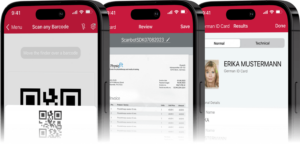Flutter
Flutter, a development framework using the programming language Dart, has been around since 2017. Both Flutter and Dart were developed by Google and are completely free and open-source. Thanks to their ease of use, excellent documentation, and quality-of-life features like hot reload, both have become favorites in the app development community.
Flutter is a great choice if you’re looking for near-native app performance on a large variety of platforms. As of version 3, it supports not only Android, iOS, Web, and Windows, but also macOS and Linux.
Advantages
Flutter brings two key advantages to the table: First, it achieves near-native performance on most devices, even though it is a cross-platform framework.
Second, Flutter is very easy to learn, thanks to its intuitive structure and excellent documentation. This means that your team can begin developing a single codebase for applications that run on all major platforms in no time.
Flutter uses the graphics engine Skia, bypassing the platform UI libraries. Through direct communication with Skia in the engine layer, which provides instructions for GPU, Flutter apps receive a performance boost.
With Flutter, interfaces typically run at 60 frames per second, or even 120 frames on capable devices. This is in part due to Dart’s runtime garbage collector, which efficiently allocates memory for the many objects Flutter renders on-screen and destroys again later.
Disadvantages
The great performance and visual fidelity of Flutter apps come at the cost of the app’s file sizes, as these are comparatively big. Since it’s a relatively young framework, you won’t find as many third-party libraries as for some other platforms, which means you might have to code quite a few things from scratch. Lastly, Dart is a niche programming language that not a lot of developers are familiar with (6.5% according to the Stack Overflow 2022 Developer Survey), so you will have to allocate some time for them to get used to it.
React Native
React Native is a framework for developing mobile applications that render natively. It does so by bridging JavaScript to the native code. Both the framework and the library are free, open-source, and developed and maintained by Meta (formerly Facebook).
React Native allows developers to write their mobile applications in JavaScript and TypeScript while giving them access to native UI elements. This not only influences the feeling of the app, but can also improve performance. And: It makes simultaneous iOS and Android development easier, since a large part of the code can be shared between the two platforms.
Advantages
Since React Native uses the popular programming language JavaScript, you have access to a wide pool of developers for your cross-platform app. To access the operating systems’ native features, you can use one of the many open-source packages available on GitHub. Many of them are easy to install with widely used package manager tools like Yarn or npm.
Developers already familiar with the React framework, used for web applications, can apply their knowledge to build mobile apps. They don’t need any knowledge of the operating systems’ native languages for this. Instead, they can use React Native’s core components during development. At build time, these are converted into their native counterparts.
Disadvantages
Although React Native is a highly popular framework for a reason, it has its drawbacks. One of them is limited platform support: While React Native allows you to use the same codebase for your iOS and Android apps, this is the end of it. Other cross-platform development frameworks cover more ground. Flutter, for instance, also supports macOS, Windows, and Linux out of the box.
Other frameworks also include more UI components that don’t rely on external libraries. If you want to add more unusual UI elements to your app, you may quickly find yourself looking for third-party packages. These may not get updates frequently, leading to security risks.

Xamarin
Xamarin, a development framework using the programming language C#, has been around since 2011, though its roots as a project called Mono go back to 2001. This project was initially developed by Miguel de Icaza and Nat Friedman as a Linux version of Microsoft’s .NET Framework.
In 2016, Microsoft bought the company Xamarin, along with the SDK of the same name. In the same year, it was announced that the open-source Xamarin would become part of Microsoft Visual Studio and that all future releases would be licensed under the MIT license. Recently, Xamarin.Forms was integrated into Microsoft’s .NET MAUI framework.
With Xamarin, you can write apps in C# for Android, iOS, macOS, and Windows using a single shared code base. With some additional tweaks in the systems’ own programming languages, you can achieve near-native performance. This makes Xamarin a viable alternative to other cross-platform frameworks like Flutter and React Native.
Advantages
If you opt for Xamarin, your C# developers can create apps for multiple platforms using a single codebase. You have the choice of two UI approaches: With Xamarin.Native (e.g., Xamarin.Android and Xamarin.iOS), you can make use of each platform’s native UI components. This way, you can create a user experience that feels right at home on the respective device. Xamarin.Forms, on the other hand, lets you leverage a shared user interface for a unified experience across devices.
C# is a popular programming language many developers are already familiar with. Being able to use it for cross-platform development is the main advantage of Xamarin, as there are a plethora of third-party libraries available.
Disadvantages
One issue arises if your project will rely heavily on visual components. With Xamarin’s design approach, your developers will have to spend a lot of time figuring out native technologies on the target platforms.
Speed and app size are also concerns: Xamarin apps, like other cross-platform apps, are generally larger in file size than natively developed ones. They might also not achieve native performance levels.
One last thing to keep in mind is that while Xamarin is open-source and can be used by individual developers free of charge, companies will have to acquire licenses for Visual Studio, which are costly.
Conclusion
Cross-platform development is a great way to deliver your app to users on many different platforms. With numerous great frameworks available free of charge, you really are spoilt for choice.
Flutter provides excellent UI capabilities and near-native performance, though it uses an uncommon programming language.
React Native leverages JavaScript to streamline cross-platform development and uses third-party libraries to access native features. However, it’s not as adaptable as Flutter.
Finally, you can count on a wide pool of resources when developing apps with Xamarin using C#. But for visually demanding apps, Flutter or React Native might be the better choices.
You can add powerful scanning functionalities to your iOS or Android app using our Scanbot SDK. On the one hand, we support native development for the best user experience and the largest selection of features. Still, on the other hand, we also support development via all common hybrid frameworks, including Flutter, React Native, and Xamarin, to make cross-platform integration as easy as possible for you. All these options ensure you have the greatest freedom of choice regarding your preferred programming language.
If you’re interested in integrating the Scanbot SDK into your mobile or web app, don’t hesitate to contact our solution experts, so we can discuss the best approach for your use case.

